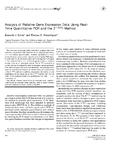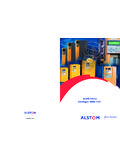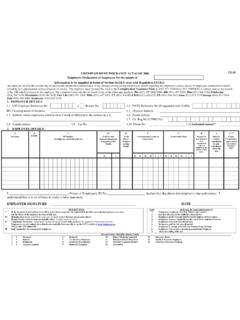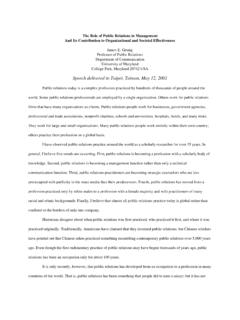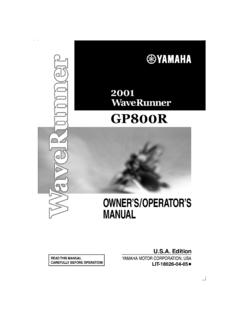Transcription of CONTRACT RESEARCH REPORT 325/2001
1 HSEH ealth & SafetyExecutiveRoot causes analysis:Literature reviewPrepared byWS Atkins Consultants Ltdfor the Health and Safety ExecutiveCONTRACT RESEARCH REPORT325/2001 HSEH ealth & SafetyExecutiveRoot causes analysis:Literature reviewA D Livingston, G Jackson& K PriestleyWS Atkins Consultants LtdScience & TechnologyWS Atkins HouseBirchwood BoulevardBirchwoodWarringtonWA3 7 WATypically an incident REPORT will place emphasis on developing a description of the consequences ratherthan causes of the incident, explaining what happened, but not why it happened. It is only by adoptinginvestigation techniques that explicitly identify root causes, ie the reasons why an incident occurred,that organisations may learn from past failures and avoid similar incidents in the future. Root causesanalysis is simply a tool designed to help incident investigators determine what, how and mostimportantly, why an incident occurred.
2 Based on this literature review it is apparent that there are three key components that need to beapplied to ensure effective root causes analysis incident investigation. These are a method ofdescribing and schematically representing the incident sequence and its contributing conditions; amethod of identifying the critical events or active failures and conditions in the incident sequence, andbased on this identification; a method for systematically investigating the management andorganisational factors that allowed the active failures to occur, ie a method for root causes analysis. Inselecting or developing a root causes analysis method, the analyst needs to consider whether themethod specifically facilitates the identification of safety management and organisational inadequaciesand oversights which relate to their own operations. The method needs to identify those factors thatexert control over the design, development, maintenance and review of their risk control systems REPORT and the work it describes were funded by the Health and Safety Executive (HSE) Itscontents, including any opinions and/or conclusions expressed, are those of the authors alone and donot necessarily reflect HSE BOOKSii Crown copyright 2001 Applications for reproduction should be made in writing to:Copyright Unit, Her Majesty s Stationery Office,St Clements House, 2-16 Colegate, Norwich NR3 1 BQFirst published 2001 ISBN 0 7176 1966 4 All rights reserved.
3 No part of this publication may bereproduced, stored in a retrieval system, or transmittedin any form or by any means (electronic, mechanical,photocopying, recording or otherwise) without the priorwritten permission of the copyright owner. iiiForeword In 1991 HSE published Successful Health and Safety Management, HSG65, ISBN 0 7176 1276 7, which described a model for health and safety management. This was followed in1993 by The Costs of Accidents at Work, HSG96, ISBN 0 7176 1343 7, which both analysed the costs of individual accidents at 5 sites over a 3 month period and discussed the background to the economic argument for good health and safety using loss control principles. The analysis confirmed earlier work by Heinrich and others on building accident pyramids, whereby a small number of fatal/serious accidents is underpinned by a much larger number of minor injuries and non injury damage occurrences.
4 HSE subsequently commissioned WS Atkins to investigate if the work in these two publications could be linked could the costs of accidents be clearly identified and linked back to specific management failures? If it could this would enable organisations to target improvement effort in a cost effective way by concentrating on well defined areas of failure. This should reduce both overall costs and accident numbers. The work involved developing and trialling two major methodologies one for capturing data on costs of accidents, which was simpler and more user friendly than the one in the original HSG96 publication, while the other was to develop a root causes analysis tool from first principles. It was for this purpose that the present literature review was undertaken something which had never been done comprehensively before. It is considered of sufficient interest in its own right to publish separately as a CONTRACT RESEARCH REPORT .
5 The original work was completed in 1995 but has been updated to cover new products up to the end of 1998. iv vContents INTRODUCTION 1 METHOD 3 SUMMARY OF INCIDENT INVESTIGATION TECHNIQUES 4 SEQUENCE DIAGRAMS 6 Principles of Sequence Diagrams 6 Conducting an Analysis 6 Events and Causal Factors Charting 7 Multilinear Events Sequencing 9 Sequentially Timed Events Plotting Procedure 10 Schematic REPORT Analysis Diagram 10 Summary 11 IDENTIFICATION OF CRITICAL EVENTS 13 Introduction 13 Barrier Analysis 13 Change Analysis 14 Fault Tree Analysis 16 Summary 18 ROOT CAUSES IDENTIFICATION - TREE
6 TECHNIQUES 20 Management Oversight and Risk Tree 20 Savannah River Plant (SRP) Root Cause Analysis System 22 TapRooTTM 24 Human Performance Investigation Process (HPIP) 26 Causal Tree Method 28 REASON Root Cause Analysis 29 Event Root Cause Analysis Procedure 30 Summary 31 ROOT CAUSES ANALYSIS - CHECKLIST METHODS 33 Human Performance Evaluation System 33 Systematic Cause Analysis Technique 34 Technique of Operations Review 36 Systematic Accident Cause Analysis (SACA) 38 Summary 39 vi ROOT CAUSES ANALYSIS - OTHER METHODOLOGIES 40 Introduction 40 American Institute of Chemical Engineers Review 40 HSYS 42 Checklists 42 Assessment of Safety Significant Teams (ASSET) 43 Safety Through Organisational Learning (SOL)
7 43 PROACTTM 45 CONCLUSIONS 46 REFERENCES 49 References Included in the Text 49 Papers Reviewed, but not Mentioned in the Text 51 References not Obtained 52 GLOSSARY 53 INTRODUCTION Typically an incident REPORT will provide an organisation with a description of events which principally focus on the status of the system at discrete moments along a timeline. Reports also usually place the emphasis on developing a description of the consequences rather than causes of the incident, explaining what happened, but not why it happened. Such analyses are almost invariably technically orientated involving detailed descriptions of plant, equipment, reactions and their governing logic systems.
8 It is only by adopting investigation techniques which explicitly identify root causes, the reasons why an incident occurred, that organisations may learn from past failures and avoid similar incidents in the future. Root causes analysis is simply a tool designed to help incident investigators describe what happened during a particular incident, to determine how it happened and to understand why it happened. The definition of a root cause varies between authors and root causes methodologies, with different levels of causation being adopted by different systems. Figure 1 illustrates the different levels of cause that can be ascribed to an incident. The root causes lie at level 1 which inevitably influence the effectiveness of all the risk control systems and workplace precautions that exist at levels 2 and 3. The most useful definition identified to date is the definition used by Paradies and Busch (1988), that is: the most basic cause that can be reasonably identified and that management has control to fix This definition, will be used for this review.
9 It contains three key elements: Basic Cause Specific reasons as to why an incident occurred that enable recommendations to be made which will prevent recurrence of the events leading up to the incident. Reasonably Identified Incident investigation must be completed in a reasonable time frame. Root causes analysis, to be effective, must help investigators to get the most out of the time allotted for investigation. Control to Fix General cause classifications such as operator error should be avoided. Such causes are not specific enough to allow those in charge to rectify the situation. Management needs to know exactly why a failure occurred before action can be taken to prevent recurrence. If the investigators arrive at vague recommendations such as Remind operator to be alert at all times , then they have probably not found a basic enough cause and need to expend more effort in the investigation process.
10 Also, if causes at level 2 and 3 are identified without investigating why the level 1 systems allowed such failures to occur, then similar or repeat incidents may occur. 2 This definition, by default, also recognises that there will be instances where incidents happen that are beyond management control. Waldram (1988) suggests that, under UK law, the extent of the control to be expected should be judged according to the test of reasonable practicability . In the majority of cases, root causes analysis methodologies have to be used by busy personnel working within the organisation where the incident occurred. Therefore, techniques need to be practical and easily applied. The application of the technique should also be prescriptive to minimise variations in user interpretations, and should encourage multiple causes to be identified, where appropriate.










